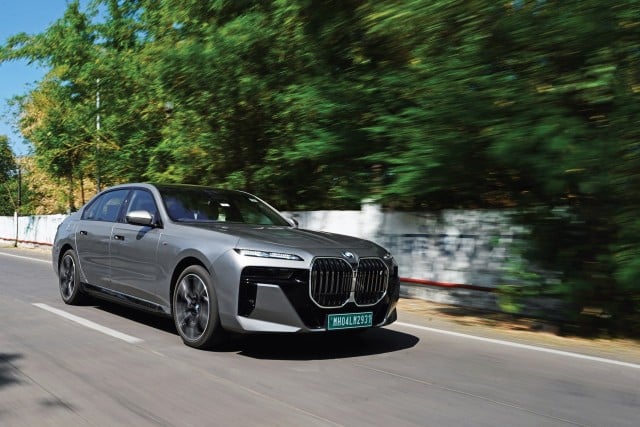
The BMW i7 wafts forward with an unconventional mix of eager effortlessness and relaxed acceleration as it rolls off the parking lot and on to the road. The ride from the 40-35 profile rubber feels commendable as I go over familiar territory. The air springs compress over the first few undulations and settle in for the ride. The steering feel is quite direct and immediate, aided by the active rear-wheel steering set-up making tight turns far easier. This is a 5.4-metre-long saloon and this feature is a boon. The ground clearance, too, isn’t much of a bother once the lift function—courtesy the two-level air suspension—is used. That raises the car 25 millimetres. It may not sound like much but it makes all the difference between grounding its belly and going over unpaved areas or speed humps cleanly. The double wishbone front and five-link rear axle with adaptive air suspension make for a comfortable ride that sees all bumps dealt with well and all undulations soaked up by sleight of hand. The impeccable feel is augmented by the i7’s damping characteristics, enhancing the engagement together with the luxurious experience. Then there are the drive modes.
These modes aren’t the regular fare either. Selected using the “My Modes” option on the centre console, the resulting response is quite dramatic. The centre screen shows a selection of modes, including Personal, Efficient, Sport, Relax, Expressive, Digital Art, and Theatre; the last one of which I need to elaborate on.
It’s easy to get accustomed to the BMW i7’s proportions. It can slice through dawdling traffic with ease and feel planted doing so. The battery pack is in the floor—with a significant centre tunnel owing to the sharing of the frame between i7 60, 760i and 760e—so the weight is low and the overall feel is extremely stable, with no detectable body-roll. Even in tight bends, with the rear-wheel steering and the sharp steering angle, the weight transfer is very subtle and every given opportunity to break free is instantly celebrated with the right foot making the acceleration the most dominating feed to the nerves. The i7 xDrive60 can go from zero to 100 km/h in just 4.7 seconds and up to a top speed of 240 km/h; not bad at all for something weighing more than 2.6 tonnes. Furthermore, the feel isn’t flat or the typical EV on/off style. There is a degree of linearity in the power delivery. Thus, it makes modulating the output easier. A stomp of the right foot results in the familiar neck-snapping torque that performance EVs have off the bat. The accompanying sound is like a star-ship priming and executing a surge. Futuristic or robotic? Depends on one’s perspective. The bottom line is, long feature list apart, every BMW is made to be driven; even these ones with a blue surround on their roundels.
The “60” points to the higher plane of offerings with V8-rivalling performance; although this xDrive60 is the only version on sale in India. The BMW i7 packs a 400-volt electrical system, a 101.7-kWh battery pack, and two electric motors, for a combined peak output of 400 kW (544 hp) and 745 Nm. The front motor offers a peak 190 kW (258 hp) with 365 Nm while the more powerful rear motor, at 230 kW, is good for up to 313 hp and 380 Nm. Interestingly, the front elektrikmaschine is only 15 Nm down on the one at the rear, so it’s a near 50:50 torque “split” and that’s what is behind that brisk acceleration.
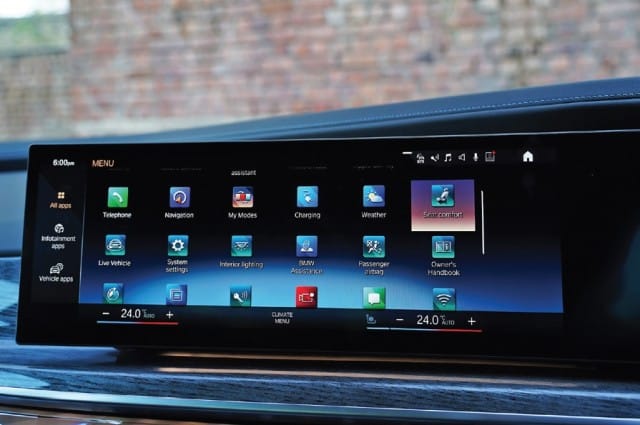
Heading to the outskirts of town, I started out with 80 per cent charge level remaining and an indicated range of 270 kilometres—the all-important figure when it comes to an electric vehicle (EV). Of course, this is calculated based on immediate or past use and, given some downhill or relaxed driving, it will go up significantly. City traffic can take a toll on the range, especially if stationary for too long with the air-conditioning, seat ventilation, and the premium 18-speaker Bowers & Wilkins surround sound system all doing what they do best. The range is rated at a maximum of 625 km on the WLTP cycle, translating into over six kilometres per kWh. However, the reality of the traffic situation in India—which involves a lot of sudden braking—means stop-go driving that has a considerable effect on the range. I reached the destination with 63 per cent range remaining and an indicated 280 km.
The BMW i7 offers both Type2 AC and CCS2 DC charging, with a 22-kW AC box taking about five-and-a-half hours for a full charge. The maximum 195 kW DC charge capacity can do 10-80 per cent in just over half an hour.
Time to sample the best seat in the house. The automatic doors doing their thing, I get in and I’m immediately greeted by a phone-like touchscreen interface. The left rear seat is equipped with the lounge function that sees the passenger seat move and fold forward with one tap on the screen. The foot-rest folds down from the front and, that’s it. Now for the 7’s party trick: Theatre mode.
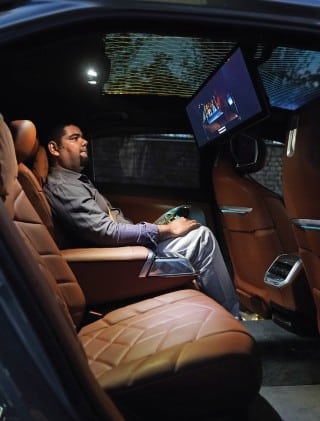
The rear window blinds raise like curtain being drawn, with an ambient sound akin to that of a much-awaited premiere. Simultaneously, a flatscreen display folds down from the roof. Next level stuff, this. The BMW Theatre Screen is a new take on rear-seat entertainment. It’s a 31.3-inch display with an 8K resolution and a 32:9 ratio. It features a built-in Amazon FireTV, an eSIM, and an HDMI port. For rear passengers, it means multimedia expansion choices, an alternative display choice for laptops, and a choice of streaming services. It can be paired with a Windows laptop, an Apple MacBook or even a Sony PlayStation!
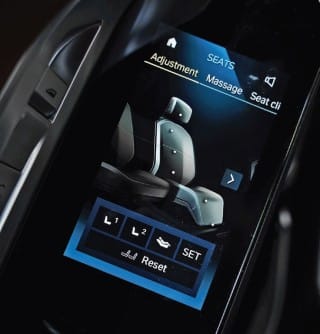
All of this comes with a price tag that says Rs 1.95 crore (ex-showroom). Being an EV, there are several benefits when it comes to road tax in several states, with just the insurance and accessories adding to the price. BMW India also have several maintenance packages for service and repairs to make for sheer ownership pleasure, if I may say so myself.
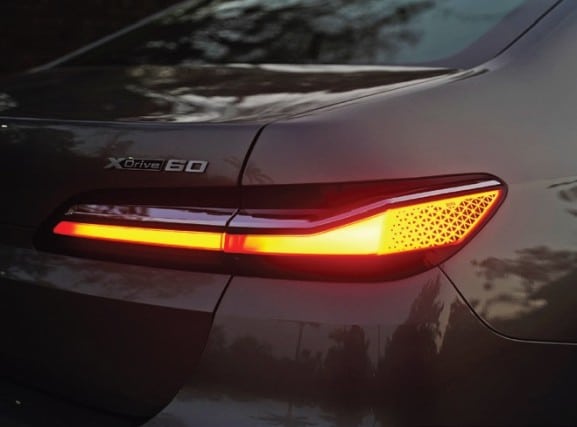
All said and done, the BMW i7 is a car that grabs eyeballs of every road-user and passer-by while—and I noted this on multiple occasions—has the police personnel not taking a second glance; not sure if it’s the blue-and-white chequered badge, the Pantheon-size grille, or the green number-plate. It’s got everything one needs and a lot more. It has features one will keep discovering for days, even weeks, into use and it offers exceptional performance and quality that raises the benchmark yet again. While the Mercedes EQS may be super-quick, it is confined to the i7’s shadow with Bavaria’s interior quality and equipment being far superior. There are few cars as opulent and well-equipped as the new 7 and a quick spin in one should be enough to immediately tell why.
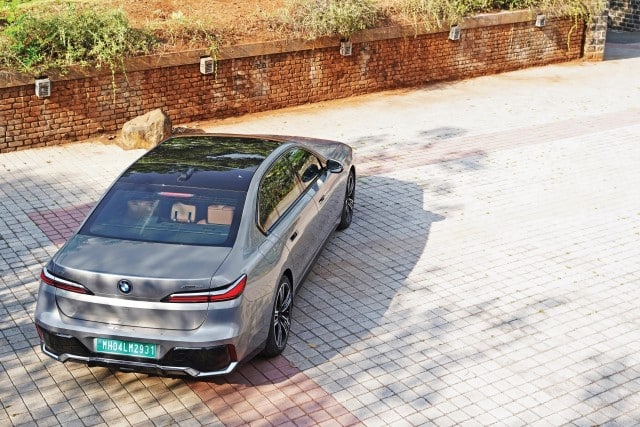
Need to Know – BMW i7 xDrive60 M Sport
Price: Rs 1.95 crore (base, ex-showroom)
Battery Pack: Lithium-ion, 280.8 Ah, 376.4 V, 288 cells, 101.7 kWh (usable)
Motor (F): Electrically excited, synchronous, 190 kW (258 hp), 365 Nm
Motor (R): Electrically excited, synchronous, 230 kW (313 hp), 380 Nm
Peak Output: 400 kW (544 hp), 745 Nm
Transmission: Single-speed, automatic, front and rear, all-wheel drive
Suspension: Double-wishbone front, five-link rear, air springs
Weight: 2,640 kg
Performance:
Power-to-weight: 206.06 hp/tonne
Acceleration (0-100 km/h): 4.7 seconds
Top Speed: 240 km/h
Efficiency: 4.9 km/kWh (overall)
Range: 625 km (claimed)
Charging: 5.5 hours (22 kW, 32A, AC), 34 minutes (195 kW DC, claimed)


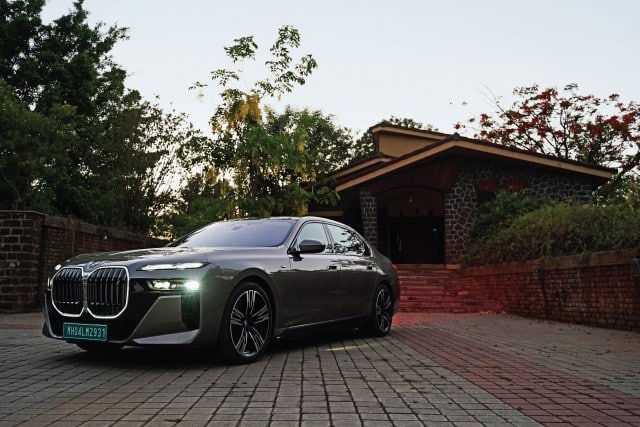


















Leave a Reply